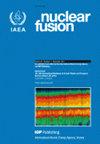Isotope effects and Alfvén eigenmode stability in JET H, D, T, DT, and He plasmas
IF 4
1区 物理与天体物理
Q1 PHYSICS, FLUIDS & PLASMAS
引用次数: 0
Abstract
While much about Alfvén eigenmode (AE) stability has been explored in previous and current tokamaks, open questions remain for future burning plasma experiments, especially regarding exact stability threshold conditions and related isotope effects; the latter, of course, requiring good knowledge of the plasma ion composition. In the JET tokamak, eight in-vessel antennas actively excite stable AEs, from which their frequencies, toroidal mode numbers, and net damping rates are assessed. The effective ion mass can also be inferred using measurements of the plasma density and magnetic geometry. Thousands of AE stability measurements have been collected by the Alfvén Eigenmode Active Diagnostic in hundreds of JET plasmas during the recent Hydrogen, Deuterium, Tritium, DT, and Helium-4 campaigns. In this novel AE stability database, spanning all four main ion species, damping is observed to decrease with increasing Hydrogenic mass, but increase for Helium, a trend consistent with radiative damping as the dominant damping mechanism. These data are important for confident predictions of AE stability in both non-nuclear (H/He) and nuclear (D/T) operations in future devices. In particular, if radiative damping plays a significant role in overall stability, some AEs could be more easily destabilized in D/T plasmas than their H/He reference pulses, even before considering fast ion and alpha particle drive. Active MHD spectroscopy is also employed on select HD, HT, and DT plasmas to infer the effective ion mass, thereby closing the loop on isotope analysis and demonstrating a complementary method to typical diagnosis of the isotope ratio.JET H、D、T、DT 和 He 等离子体中的同位素效应和阿尔芬特征模式稳定性
虽然在以前和当前的托卡马克中已经探索了很多关于阿尔芬特征模(AE)稳定性的问题,但对于未来的燃烧等离子体实验来说,仍有很多问题有待解决,特别是关于确切的稳定性阈值条件和相关的同位素效应;当然,后者需要很好地了解等离子体的离子组成。在 JET 托卡马克中,八个腔内天线主动激发稳定的 AE,并从中评估其频率、环模数和净阻尼率。通过测量等离子体密度和磁性几何形状,还可以推断出有效离子质量。在最近的氢、氘、氚、DT 和氦-4 活动中,阿尔文特征模式主动诊断仪在数百个 JET 等离子体中收集了数千次 AE 稳定性测量结果。在这个涵盖所有四种主要离子的新型 AE 稳定性数据库中,可以观察到阻尼随氢质量的增加而减小,但氦质量的增加而增大,这一趋势与辐射阻尼作为主要阻尼机制是一致的。这些数据对于预测未来装置在非核(氢/氦)和核(D/T)运行中的 AE 稳定性非常重要。特别是,如果辐射阻尼在整体稳定性中起着重要作用,那么即使在考虑快速离子和阿尔法粒子驱动之前,某些 AE 在 D/T 等离子体中可能比其 H/He 参考脉冲更容易失稳。在选定的 HD、HT 和 DT 等离子体中还采用了主动 MHD 光谱法来推断有效离子质量,从而结束了同位素分析的循环,并展示了典型同位素比诊断的补充方法。
本文章由计算机程序翻译,如有差异,请以英文原文为准。
求助全文
约1分钟内获得全文
求助全文
来源期刊

Nuclear Fusion
物理-物理:核物理
CiteScore
6.30
自引率
39.40%
发文量
411
审稿时长
2.6 months
期刊介绍:
Nuclear Fusion publishes articles making significant advances to the field of controlled thermonuclear fusion. The journal scope includes:
-the production, heating and confinement of high temperature plasmas;
-the physical properties of such plasmas;
-the experimental or theoretical methods of exploring or explaining them;
-fusion reactor physics;
-reactor concepts; and
-fusion technologies.
The journal has a dedicated Associate Editor for inertial confinement fusion.
 求助内容:
求助内容: 应助结果提醒方式:
应助结果提醒方式:


